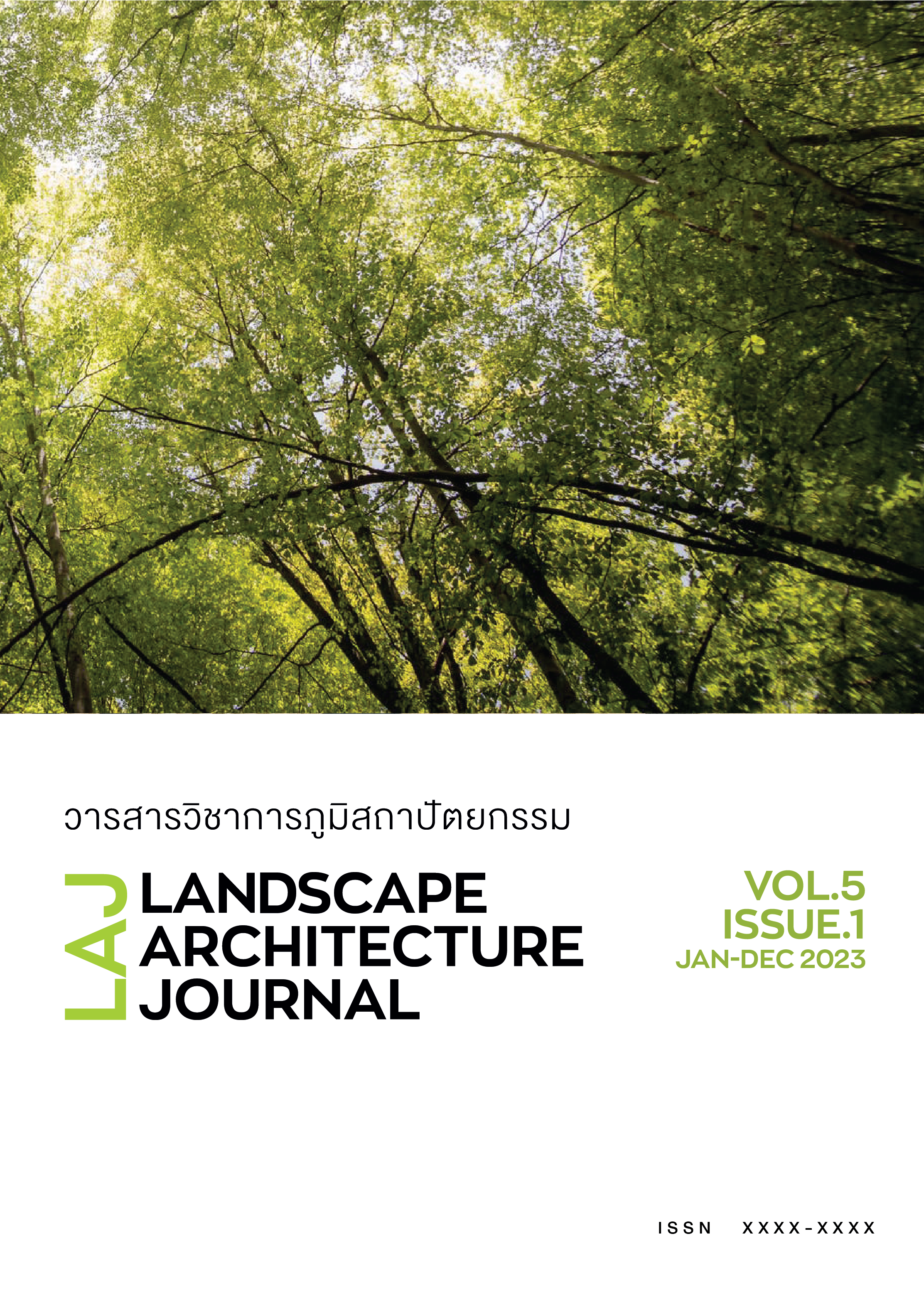Persistence and Change of Lanna Vernacular Landscape: Case Studies of Agricultural Community in Mueang Khong Basin, Chiang Dao District, Chiang Mai
Main Article Content
Abstract
This research article aims to study the characteristics of the vernacular landscape of the agricultural communities in the Mueang Khong Basin, to find factors related to the persistence and change of the vernacular landscape, and to propose recommendations to support vernacular landscape conservation and management. This work was field research using the ecological and landscape survey and the unstructured interview as a tool for data collection. The sample group was four agricultural communities, eight case houses, and twenty key informants. The researcher uses physical data analysis and data from interviews, presenting data through description, map, and figure. The results showed a blend of traditional and modern vernacular landscapes of the agricultural communities that settled in this area. First, factors related to the persistence of vernacular landscapes include community participation and cultural pride, preservation and restoration of the community's cultural heritage, adoption of sustainable agricultural practices, supporting policies and plans to promote and preserve environmental quality, transfer of local knowledge, and community-based tourism. Second, factors associated with the change in the vernacular landscape include urban and community infrastructure development, modernization and technological advancement, socio-economic changes, cultural and global influences, environmental challenges, climate change, related policies and regulations, and population change and migration. Finally, suggestions to support the conservation and management of Lanna vernacular landscapes include promoting community participation, education, and raising awareness in Lanna vernacular landscape conservation and management, capacity building to the local community, promoting stakeholder collaboration, developing policies and guidelines, sustainable tourism, promoting ongoing research and monitoring of the Lanna vernacular landscape, and supporting the development of a database and documentation on with Lanna vernacular landscape.
Article Details

This work is licensed under a Creative Commons Attribution-NonCommercial-NoDerivatives 4.0 International License.
References
เกรียงไกร เกิดศิริ. (2557). องค์รวมภูมิทัศน์วัฒนธรรมชุมชนและสถาปัตยกรรมพื้นถิ่นเรือนที่อยู่อาศัยในลุ่มน้ำทะเลสาบ
สงขลา. วารสารหน้าจั่ว ว่าด้วยประวัติศาสตร์สถาปัตยกรรมและสถาปัตยกรรมไทย, 11(2014), 177-213.
ทรงภพ เมฆพรรณโอภาส อำภา บัวระภา และ ธีดา นามไห. (2563). การออกแบบพื้นที่่เกษตรกรรมเพื่อความยั่งยืน อำเภอ
วาปีปทุม จังหวัดมหาสารคาม. วารสารสถาปัตยกรรม การออกแบบและการก่อสร้าง คณะสถาปัตยกรรมศาสตร์ ผังเมือง
และนฤมิตศิลป์ มหาวิทยาลัยมหาสารคาม, 2(2), 41-51.
เทิดศักดิ์ เตชะกิจขจร เสฎฐวุฒิ บําารุงกุล และ ปิยะธิดา สายขุน. (2563). การบริหารจัดการการท่องเที่ยวในเขตอนุรักษ์มรดก
ทางวัฒนธรรม (สถาปัตยกรรม) เมืองเก่าลำพูน แพร่ น่าน. วารสารมนุษยศาสตร์สังคมศาสตร์, 37(2), 38-63.
ธันยา พรหมบุรมย์. (2564). รายงานฉบับสมบูรณ์การทดลองจัดโปรแกรมเส้นทางท่องเที่ยว ตำบลเมืองคอง อำเภอเชียงดาว
จังหวัดเชียงใหม่. เชียงใหม่: มหาวิทยาลัยเชียงใหม่.
นวณัฐ โอศิริ. (2545). ภูมิทัศน์พื้นถิ่น ภูมิปัญญาเพื่อการประหยัดพลังงานและการพัฒนาอย่างยั่งยืน กรณีศึกษา หมู่บ้านตาล
เหนือ อำเภอฮอด จังหวัดเชียงใหม่. ในการประชุมสาระศาสตร์: การประชุมวิชาการประจำปี สถาปัตยกรรมและศาสตร์
ครั้งที่ 6 ฉบับการวางแผนภาคและผังเมือง ภูมิสถาปัตยกรรม 1. กรุงเทพฯ: มหาวิทยาลัยธรรมศาสตร์.
มาริสา หิรัญตียะกุล และ นพดล ตั้งสกุล. (2565). การศึกษาอัตลักษณ์ถิ่นที่ในสิ่งแวดล้อมสรรค์สร้าง. วารสารวิจัยและสาระ
สถาปัตยกรรม/การผังเมือง, 19(1), 99-114.
มาลินี เกลี้ยงล่ำ. (2564). การบริหารการพัฒนาชุมชนเกษตรกรรมสมัยใหม่บนฐานสังคมล้านนาไทย. วารสาร มจร.หริภุญชัย
ปริทรรศน์, 5(2), 59-70.
วัชรพงษ์ ชุมดวง. (2561). การบูรณาการท่องเที่ยวเชิงสร้างสรรค์ด้วยต้นทุนทางมรดกวัฒนธรรมและกระบวนการมีส่วนร่วม
ของชุมชน: กรณีศึกษา ชุมชนเมืองเก่าสุโขทัย. วารสารครุศาสตร์อุตสาหกรรม, 17(3), 30-39.
วิมลรัตน์ อิสระธรรมนูญ. (2560). การจัดการภูมิทัศน์วัฒนธรรมในฐานะเครื่องมือในการสร้างความยั่งยืนและความยืดหยุ่นต่อ
การเปลี่ยนแปลงของชุมชน. วารสารหน้าจั่ว ว่าด้วยสถาปัตยกรรม การออกแบบ และสภาพแวดล้อม, 32(2017),
E03-E28.
วีระ อินพันทัง. (2559). สิ่งแวดล้อมสรรค์สร้างพื้นถิ่น: การดำรงและการเปลี่ยนแปลง. วารสารหน้าจั่ว ว่าด้วยสถาปัตยกรรม
การออกแบบ และสภาพแวดล้อม, 30(2016), A126-A142.
ศนิ ลิ้มทองสกุล. (2549). ภูมิทัศน์พื้นถิ่นของหมู่บ้านชนบทในชุมชนชาวมุสลิมในประเทศไทยและประเทศมาเลเซีย. วารสาร
วิจัยและสาระสถาปัตยกรรม / การผังเมือง, 4(2), 141-154.
สรัสวดี อ๋องสกุล. (2561). ประวัติศาสตร์ล้านนา. กรุงเทพฯ : สำนักพิมพ์อมรินทร์.
สินีนาถ ศุกลรัตนเมธี. (2558). องค์ประกอบในการออกแบบสภาพแวดล้อมที่ช่วย ส่งเสริมความรู้สึกเป็นส่วนหนึ่งของชุมชน.
วารสารหน้าจั่ว ว่าด้วยสถาปัตยกรรม การออกแบบ และสภาพแวดล้อม, 29(2015), 475-488.
อัมพิกา อำลอย ศุภกุล เรืองวิทยานุสรณ์ วรงค์ วงศ์ลังกา แผ่นดิน อุนจะนำ อรัญญา ศิริผล และระวิวรรณ โอฬารรัตน์มณี.
(2565). การศึกษาภูมิทัศน์พื้นถิ่นล้านนาในบริบทชุมชนของนักวิชาการไทยในประเทศไทย ช่วง พ.ศ. 2545-2564.
วารสารวิชาการภูมิสถาปัตยกรรม, 4(1), 62-81.
อำภา บัวระภา. (2562). รูปแบบและปัจจัยการคงอยู่ของภูมิทัศน์พิื้นถิ่น “บ้านเรือนและที่อยู่อาศัย” แขวงคำม่วนสาธารณรัฐ
ประชาธิปไตยประชาชนลาว. วารสารสถาปัตยกรรมศาสตร์ ผังเมืองและนฤมิตศิลป์ มหาวิทยาลัยมหาสารคาม, 1(1),
-22.
อุทิศ ทาหอม พิชิต วันดี และ สำราญ ธุระตา. (2558). ทุนทางวัฒนธรรมและภูมิปัญญาท้องถิ่นของชุมชนบ้านตามาเพื่อสร้าง
การมีส่วนร่วมในการจัดการทรัพยากรธรรมชาติและสิ่งแวดล้อมของชุมชน. วารสารการจัดการสิ่งแวดล้อม, 11(2),
-59.

